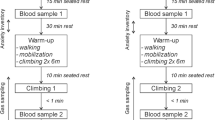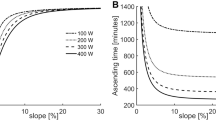Abstract
In some types of human and animal locomotion, speed influences the amount of metabolic energy expended per unit mass and distance (energy cost, EC) and as speed decreases or increases away from a healthy person’s self-selected speed (SSS), the EC increases. When asked to climb a vertical wall using their preferred speed, similar to walking, climbers with the same level of skill spontaneously select comparable speeds. The present research was designed to investigate how speed of ascent affects the EC of climbing; we were also interested in finding out whether climbers with the same level of skill exhibit a common SSS and if it is correlated with optimal economy (i.e. minimum EC). A representative experimental set-up was prepared to quantify the economy of rock climbing by measuring steady-state oxygen intake (VO2) in very skilled climbers while climbing at their SSS and at higher (HS) and lower (LS) speed, and computing the relative EC. The main findings were: (a) climbers with the same level of skill exhibited the same preferred climbing speed (10.2 ± 1.5 m·min−1) at the same fraction of their maximum VO2 (VO2peak) measured on a cycle ergometer (71.7 ± 15.2%), and (b) climbing economy continuously increased as speed increased from LS to HS. Thus climbing at the SSS does not correspond to the optimal economy. A possible explanation for these findings may be that although it does not match the minimum EC, the SSS would be the best compromise between the need to reduce the time spent in isometric work (useless and costly) and the need to avoid early muscle fatigue due to increased speed and frequency of muscle contraction.
Similar content being viewed by others
References
Watts PB (2004) Physiology of difficult rock climbing. Eur J Appl Physiol 91:361–372
Sheel AW (2004) Physiology of sport rock climbing. Br J Sports Med 38:355–359
Watts PB, Drobish KM (1998) Physiological responses to simulated rock climbing at different angles. Med Sci Sports Exerc 30:1118–1122
De Moraes Bertuzzi RC, Franchini E, Kokubun E et al (2007) Energy system contributions in indoor rock climbing. Eur J Appl Physiol 101:293–300
Mermier CM, Robergs RA, McMinn SM, Heyward VH (1997) Energy expenditure and physiological responses during indoor rock climbing. Br J Sports Med 31:224–228
Watts PB, Clure CA, Hill MR, et al (1995) Energy costs of rock climbing at different paces (abstract). Med Sci Sports Exerc 27:S17
de Geus B, O’Driscoll SV, Meeusen R (2006) Influence of climbing style on physiological responses during indoor rock climbing on routes with the same difficulty. Eur J Appl Physiol 98:489–496
Margaria R (1938) Sulla fisiologia e specialmente sul consumo energetico della marcia e della corsa a varia velocità ed inclinazione del terreno. Atti Accad Nazional Lincei 7:299–368
Tosi P, Leonardi A, Zerbini L et al (2010) Energy cost and efficiency of ski mountaineering. A laboratory study. J Sports Med Phys Fitness 50:400–406
di Prampero PE (1986) The energy cost of human locomotion on land and in water. Int J Sports Med 7:55–72
Full RJ, Tullis A (1990) Energetics of ascent: insects on inclines. J Exp Biol 149:307–317
Rodio A, Fattorini L, Rosponi A et al (2008) Physiological adaptation in noncompetitive rock climbers: good for aerobic fitness? J Strength Cond Res 22(2):359–364
Sibella F, Frosio I, Schena F, Borghese NA (2007) 3D analysis of the body center of mass in rock climbing. Hum Mov Sci 26:841–852
Malatesta D, Simar D, Dauvilliers Y et al (2004) Aerobic determinants of the decline in preferred walking speed in healthy, active 65- and 80-years-olds. Pflugers Arch 447:915–921
Martin PE, Rothstein DE, Larish DD (1992) Effects of age and physical activity status on the speed-aerobic demand relationship of walking. J Appl Physiol 73:200–206
UIAA. Climbing scale conversion. International Mountaineering and Climbing Federation, Bern. http://www.theuiaa.org/guidebook_standards.html; Comparison between UIAA grades and other grading systems.pdf
Wasserman K (1986) The anaerobic threshold: definition, physiological significance and identification. Adv Cardiol 35:1–23
Wasserman K (1987) Determinants and detection of anaerobic threshold and consequences of exercise above it. Circulation 76 (Suppl VI):VI29–VI39
Duffield R, Dawson B, Pinnington HC, Wong P (2004) Accuracy and reliability of a Cosmed K4b2 portable gas analysis system. J Sci Med Sport 7(1):11–22
Eisenmann JC, Brisko N, Shadrick D, Welsh S (2003) Comparative analysis of the Cosmed Quark b2 and K4b2 gas analysis systems during submaximal exercise. J Sci Med Sport 43(2):150–155
Hopkins WG (2000) Measures of reliability in sports medicine and science. Sports Med 30(1):1–15
Hopkins WG (2007) A new view of statistics. Internet Society for Sport Science. http://sportsci.org/resource/stats/xrely.xls
Booth J, Marino F, Hill C, Gwinn T (1999) Energy cost of sport rock climbing in elite performers. Br J Sports Med 33:14–18
Waters RL, Mulroy S (1999) The energy expenditure of normal and pathologic gait. Gait Posture 9(3):207–231
Baker R, Hausch A, McDowell B (2001) Reducing the variability of oxygen consumption measurements. Gait Posture 13:202–209
Sparrow WA, Newell KM (1998) Metabolic energy expenditure and regulation of movement economy. Psychon Bull Rev 5:173–196
Quaine F, Martin L (1999) A biomechanical study of equilibrium in sport rock climbing. Gait Posture 10:233–239
Noè F, Quaine F, Martin L (2001) Influence of steep gradient supporting walls in rock climbing: biomechanical analysis. Gait Posture 13:86–94
Zarrugh MY, Todd FN, Ralston HJ (1974) Optimization of energy expenditure during level walking. Eur J Appl Physiol 33:293–306
Mazzoni P, Hristova A, Krakauer JW (2007) Why don’t we move faster? Parkinson’s disease, movement vigor, and implicit motivation. J Neurosci 27(27):7105–7116
Hogan MC, Ingham E, Kurdak SS (1998) Contraction duration affects metabolic energy cost and fatigue in skeletal muscle. Am J Physiol Endocrinol Metab 274:E397–E402
Billat V, Palleja P, Charlaix T et al (1995) Energy specificity of rock climbing and aerobic capacity in competitive sport rock climbers. J Sports Med Phys Fitness 35:20–24
Roberts TJ, Kram R, Weyand PG, Taylor R (1998) Energetics of bipedal running. I. metabolic cost of generating force. J Exp Biol 201:2745–2751
Hoelting BD, Sheuermann BW, Barstow TJ (2001) Effect of contraction frequency on leg flow during knee extension exercise in humans. J Appl Physiol 91:671–679
Donovan CM, Brooks GA (1977) Muscular efficiency during steady-rate exercise. II. Effects of walking speed and work rate. J Appl Physiol 43:431–439
Williams JH (1997) Contractile apparatus and sarcoplasmic reticulum function effects of fatigue, recovery, and elevated Ca2+. J Appl Physiol 83:444–450
Author information
Authors and Affiliations
Corresponding author
Rights and permissions
About this article
Cite this article
Rosponi, A., Schena, F., Leonardi, A. et al. Influence of ascent speed on rock climbing economy. Sport Sci Health 7, 71–80 (2012). https://doi.org/10.1007/s11332-012-0115-8
Received:
Accepted:
Published:
Issue Date:
DOI: https://doi.org/10.1007/s11332-012-0115-8




